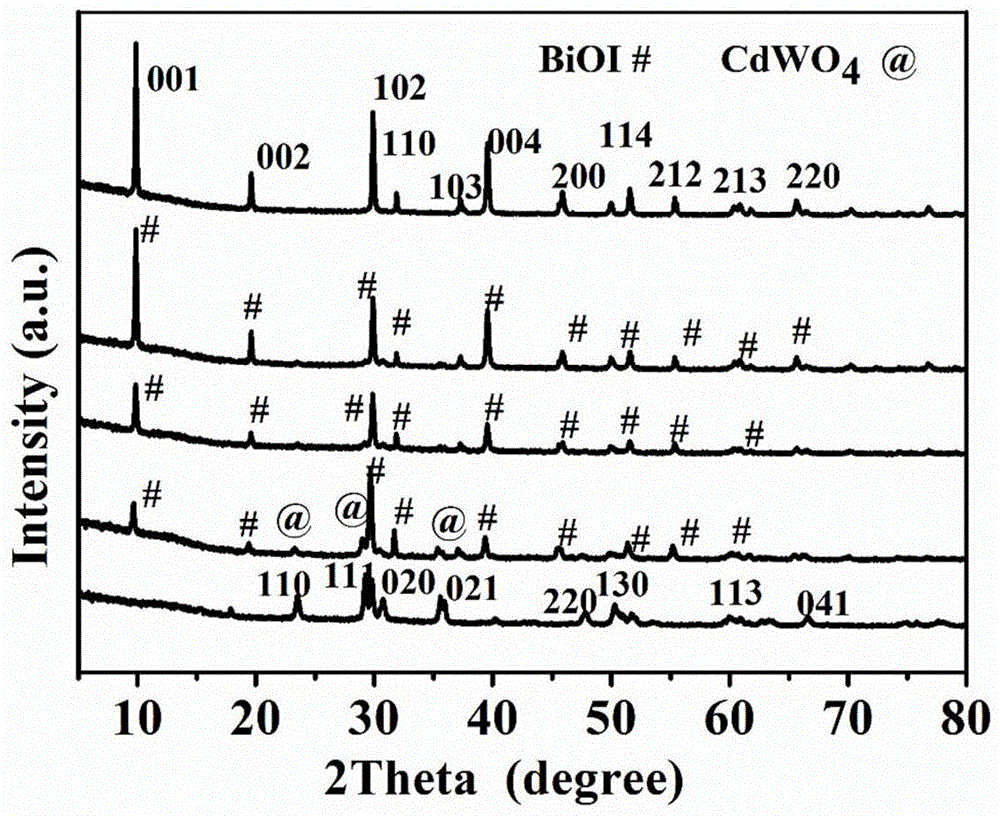Method for preparing BiOI / CdWO4 heterojunction photocatalyst
A photocatalyst and heterojunction technology, applied in physical/chemical process catalysts, chemical instruments and methods, chemical/physical processes, etc., can solve problems such as limiting photoelectric conversion efficiency
- Summary
- Abstract
- Description
- Claims
- Application Information
AI Technical Summary
Problems solved by technology
Method used
Image
Examples
Embodiment 1B
[0020] Example 1BiOI / CdWO 4 Preparation of nanorods
[0021] The solution containing 1mmol of chromium acetate was added to the solution containing 1mmol of sodium tungstate. After ultrasonic and magnetic stirring, the hydrothermal reaction was carried out. The hydrothermal reaction was carried out at 160℃ for 24 hours. After the reaction, the precipitate was filtered, washed, and at 60℃. Drying to obtain cadmium tungstate; take the prepared cadmium tungstate and disperse it in deionized water, add equimolar potassium iodide and bismuth nitrate under stirring conditions, control the molar ratio of bismuth nitrate to cadmium tungstate to 1.0, 1.5 and 2.0 respectively , After ultrasonic stirring and uniform dispersion, the precipitate is washed with deionized water and ethanol, filtered, and dried in a constant temperature drying box at 60°C to obtain BiOI / CdWO 4 Heterojunction composite photocatalyst.
Embodiment 2B
[0022] Example 2BiOI / CdWO 4 Characterization and Analysis of Heterojunction Composite Photocatalyst
[0023] Such as figure 1 As shown, it can be seen from the figure that the composite sample has both BiOI and CdWO 4 The characteristic peaks indicate that we have successfully prepared BiOI / CdWO 4 Heterojunction composite photocatalyst.
[0024] Such as figure 2 As shown, (A) you can see the nanorod-shaped CdWO 4 Irregular nano-particle BiOI is loaded on the surface.
[0025] Such as image 3 As shown, the spectrum shows the presence of Bi, O, I, Cd, W and O elements.
[0026] Such as Figure 4 As shown, the figure shows the heterojunction BiOI / CdWO 4 After four cyclic tests, the performance of the catalyst did not decrease significantly, which proves that the catalyst we synthesized has strong stability.
Embodiment 3B
[0027] Example 3BiOI / CdWO 4 Visible light catalytic activity experiment of heterojunction composite photocatalyst
[0028] (1) Prepare a rhodamine B solution with a concentration of 10 mg / L, and place the prepared solution in a dark place.
[0029] (2) Weigh BiOI / CdWO 4 Heterojunction composite photocatalyst 100mg (when BiOI and CdWO 4 The samples obtained with the molar ratio of 1:1, 1.5:1 and 2.0:1 are denoted as BC-1.0, BC-1.5, BC-2.0), respectively, placed in the photocatalytic reactor, and added 100 mL of step (1) After the prepared target degradation solution is magnetically stirred for 30 minutes, after the composite photocatalyst is uniformly dispersed, the water source and light source are turned on, and the photocatalytic degradation experiment is carried out.
[0030] (3) Aspirate the photocatalytic degradation liquid in the reactor every 10 minutes, and use it for the measurement of UV-visible absorbance after centrifugation.
[0031] (4) by Figure 5 It can be seen that t...
PUM
 Login to View More
Login to View More Abstract
Description
Claims
Application Information
 Login to View More
Login to View More - R&D
- Intellectual Property
- Life Sciences
- Materials
- Tech Scout
- Unparalleled Data Quality
- Higher Quality Content
- 60% Fewer Hallucinations
Browse by: Latest US Patents, China's latest patents, Technical Efficacy Thesaurus, Application Domain, Technology Topic, Popular Technical Reports.
© 2025 PatSnap. All rights reserved.Legal|Privacy policy|Modern Slavery Act Transparency Statement|Sitemap|About US| Contact US: help@patsnap.com



